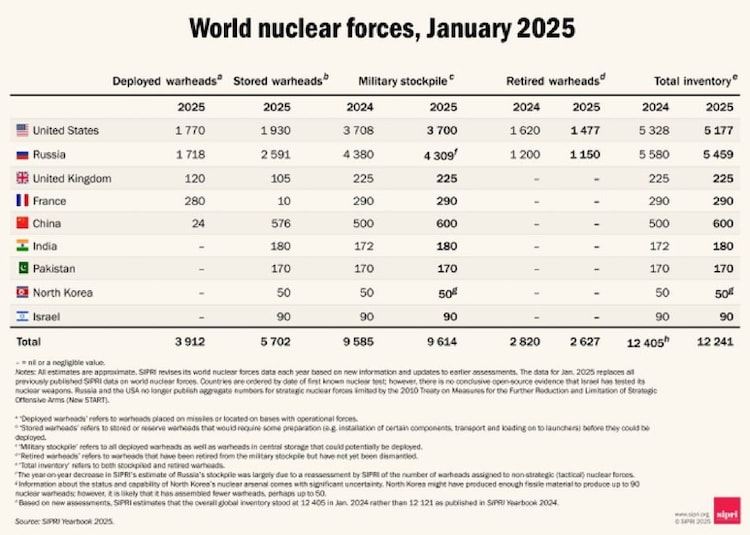Context:
India has overtaken Pakistan in the number of nuclear warheads it possesses, although China remains far ahead of both countries, according to the Stockholm International Peace Research Institute (SIPRI) Yearbook 2025.
Key Highlights of the report:
· As of January 2025, SIPRI estimates:
o India: 180 stored nuclear warheads
o Pakistan: 170 stored nuclear warheads
o China: 600 nuclear warheads (24 deployed)
· These estimates place India ahead of Pakistan in the nuclear arms race for the first time in years. However, China's nuclear arsenal is more than triple that of India.
· According to the report, India slightly expanded its nuclear arsenal in 2024 and made notable progress in developing new nuclear delivery systems, especially its ‘canisterised’ missiles.
o These missiles are designed for rapid deployment and can carry nuclear warheads already mated during peacetime—a potential shift from India’s long-standing policy of storing warheads separately from delivery systems.
· SIPRI notes that this change could represent a significant doctrinal evolution in India’s nuclear posture, particularly as part of its growing focus on deterring not just Pakistan but China as well.
· India’s nuclear weapons are now assigned to a maturing nuclear triad, comprising:
o Land-based missiles
o Aircraft capable of delivering nuclear weapons
o Nuclear-powered ballistic missile submarines (SSBNs) conducting sea-based deterrence patrols
China’s Rapid Expansion:
China’s nuclear buildup remains the most dramatic in Asia, with 600 warheads now in its arsenal—up from 410 in 2023. SIPRI notes that 24 of these are already deployed, meaning they are either mounted on missiles or ready for immediate use by operational forces.
China has also developed at least two types of missiles capable of carrying multiple independently targetable re-entry vehicles (MIRVs)—a capability that only the US, Russia, UK, and France had until the mid-2000s. India, Pakistan, and North Korea are all reportedly pursuing similar capabilities.
Nuclear Powers and Global Trends
- United States and Russia remain dominant, with 5,459 and 5,177 warheads respectively (including retired stockpiles).
- All nine nuclear-armed states (US, Russia, UK, France, China, India, Pakistan, Israel, and North Korea) are modernising their arsenals.
- Dual-capable missile systems, usable for both conventional and nuclear payloads, are being deployed by Russia, China, India, Pakistan, and North Korea.
India’s Geostrategic Focus Shifting Toward China
- Although Pakistan remains India’s primary nuclear focus, SIPRI notes that India is increasingly developing longer-range weapons that can reach deep into Chinese territory. This aligns with India’s broader strategic shift toward counterbalancing China’s military growth, particularly in the context of border tensions and regional rivalry in the Indo-Pacific.
- SIPRI also identified India as one of the top five arms importers globally from 2020 to 2024, alongside Ukraine, Qatar, Saudi Arabia, and Pakistan. These five nations together accounted for 35% of global arms imports, underscoring the centrality of arms acquisition to strategic planning in South Asia.
Conclusion:
As nuclear doctrines shift and weapons capabilities grow more sophisticated, SIPRI’s findings stress the need for transparency, arms control dialogue, and confidence-building measures in Asia to avert miscalculations and crises.







